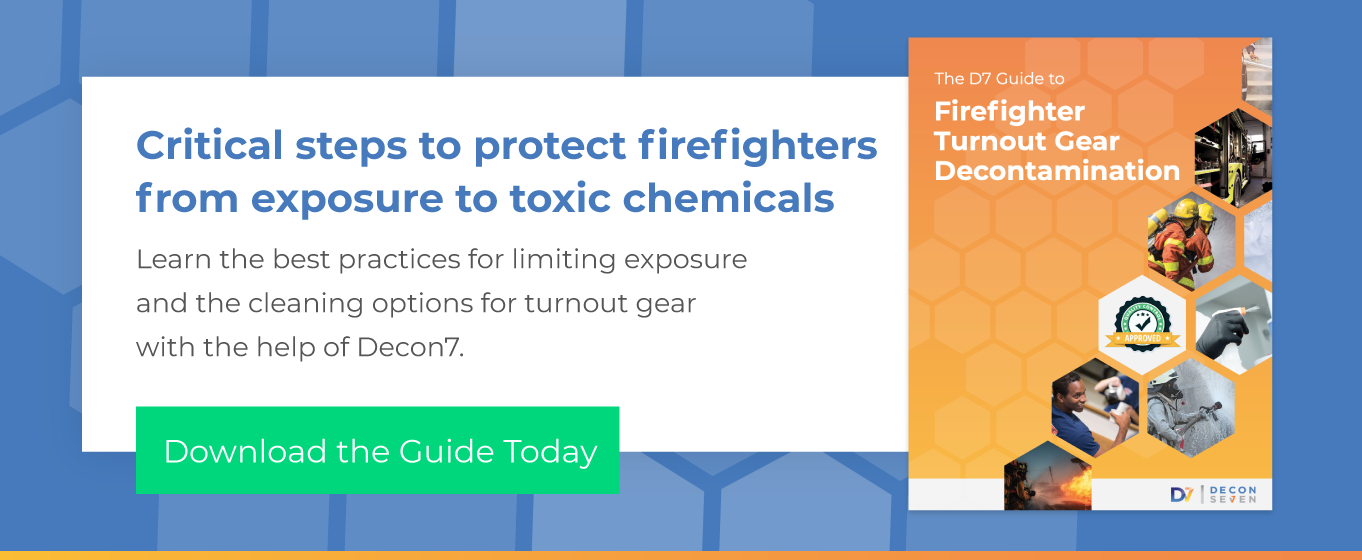.png?width=1160&name=Decon7%20Blog%20%23122%20(1).png) The health risks to firefighters extend well beyond the immediate threats of flames, heat, and smoke. The fact is that toxic chemicals remain on turnout gear long after leaving the fireground, potentially resulting in long-term health effects, such as firefighter cancer and other chronic issues. Carcinogens on firefighter gear can also transfer to other areas, potentially contaminating vehicles, lockers, clothing, and personal effects. By using proper firefighter gear cleaning solutions, teams can reduce exposure to harmful carcinogens.
The health risks to firefighters extend well beyond the immediate threats of flames, heat, and smoke. The fact is that toxic chemicals remain on turnout gear long after leaving the fireground, potentially resulting in long-term health effects, such as firefighter cancer and other chronic issues. Carcinogens on firefighter gear can also transfer to other areas, potentially contaminating vehicles, lockers, clothing, and personal effects. By using proper firefighter gear cleaning solutions, teams can reduce exposure to harmful carcinogens.
Fire Service Decontamination Procedures
The National Fire Protection Association (NFPA) 1851 standard for personal protective equipment (PPE) is the industry guidance that outlines the care and maintenance of firefighter gear.
Inspection
Individuals should inspect their gear at the beginning of each shift and after each use. Inspectors should wear appropriate PPE, including gloves at minimum and aprons and respirators if warranted. When inspecting, look for:
-
- Rips or tears
- Soiling
- Contamination
- Damaged hardware or closures
- Thermal damage
- Damaged reflective trim
- Damaged seams or stitches
- Correct assembly of shell, liner, and rescue devices
Gear that is soiled or contaminated should be cleaned before additional inspection. If advanced cleaning is required, the gear should be tagged and removed from service until decontamination is complete. Any gear contaminated with CBRN (chemical, biological, radiological, nuclear) agents should be retired.
Cleaning Guidelines
When required, cleaning can be performed in-house by a team that is trained or verified by a manufacturer. Soiled materials cannot be laundered in homes or public laundry facilities, and commercial dry cleaning is not recommended.
After each use, follow the flow chart in NFPA 1851 figure 7.1.1.2(a) to determine the appropriate cleaning and disinfection response. Depending on the type of exposure, follow the steps in the guidance:
-
- CBRN: Retire the equipment.
- Hazardous materials: Perform preliminary exposure reduction, inspection by a qualified team, or specialized cleaning (if possible). If cleaning is not possible, retire the equipment.
- Contamination: Perform preliminary exposure reduction and cleaning depending on the type of contamination.
- Soiling: Perform preliminary exposure reduction and advanced cleaning as needed.
When contamination is suspected or confirmed, follow the flow chart in NFPA 1851 figure 7.1.1.2(b) that addresses treatment procedures for:
-
- Bulk chemicals
- Asbestos
- Body fluids
- Products of combustion
Preliminary Exposure Reduction
Immediately upon exiting the scene, remain on a self-contained breathing apparatus (SCBA) and take steps to reduce exposure to potentially harmful chemicals and carcinogens. Use dry (brushing with a soft-bristle brush) or wet (gently rinsing with low-pressure, low-volume water with or without a detergent) mitigation techniques to remove debris before removing gear. Heavy scrubbing or high-pressure washing is not recommended. Remove and bag the gear, but do not transport it in the passenger area of the vehicle even when it’s bagged.
Advanced Cleaning
Trained team members are responsible for advanced cleaning and coordination. All soiled or contaminated gear should be subject to advanced cleaning, with specialized cleaning required for gear exposed to bulk chemicals, unusual biological contaminants, asbestos, or other hazardous materials. Additionally, all gear should be subject to advanced cleaning at least once every six months, even if not warranted by a specific incident.
When machine cleaning is specified, the equipment must meet NFPA specifications—top-loading washers are not recommended. Do not use bleach and other chlorine-based solvents unless specified by the gear manufacturer. Instead, use a mild detergent with a pH between 6.0 and 10.5. Gear must be dried using a drying cabinet or air-drying out of direct sunlight.
Sanitation and Disinfection
All gear exposed that has been exposed to bodily fluids must be disinfected with an EPA-registered product approved for that use. Closely follow the instructions for use, including any application methods, minimum contact times, and rinsing requirements.
D7 for Cleaning Firefighter Gear
D7 is a cleaner and chemical neutralizer that is EPA-registered as a disinfectant and laundry sanitizer. It is safe to apply and does not degrade gear materials or equipment. The unique formulation cleans and neutralizes chemicals at the same time, reducing the number of resources required. The product can be used at the fireground as a spray or foam to neutralize chemicals, reduce exposure to carcinogens, and decrease the chances of cross-contamination. D7 can also be used as a liquid in laundry or as a pretreatment soak.
If you’re struggling to find time for fire service decontamination procedures, schedule the Decon7 Mobile Extraction Unit to come to your site and do it for you.
For more practical tips you can use to reduce the risk of exposure to harmful carcinogens, read The Decon7 Guide to Firefighter Turnout Gear Decontamination.


